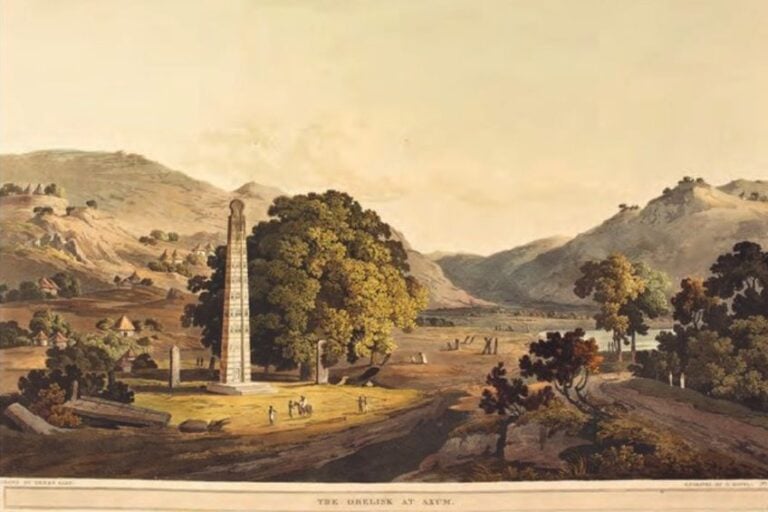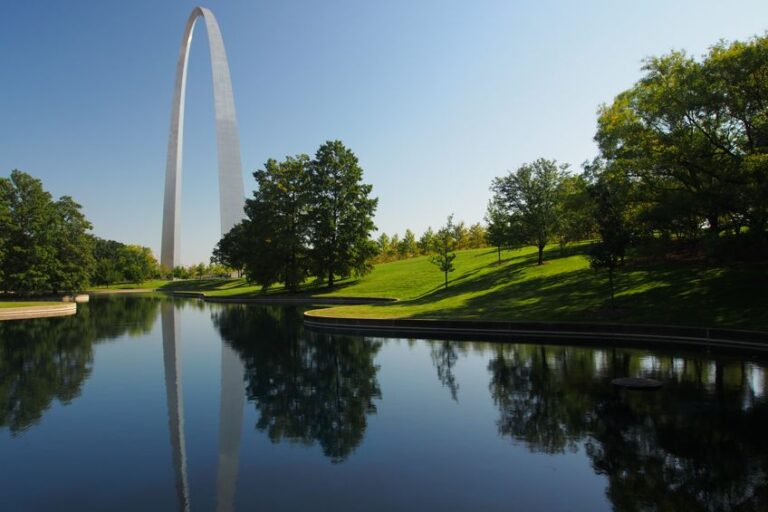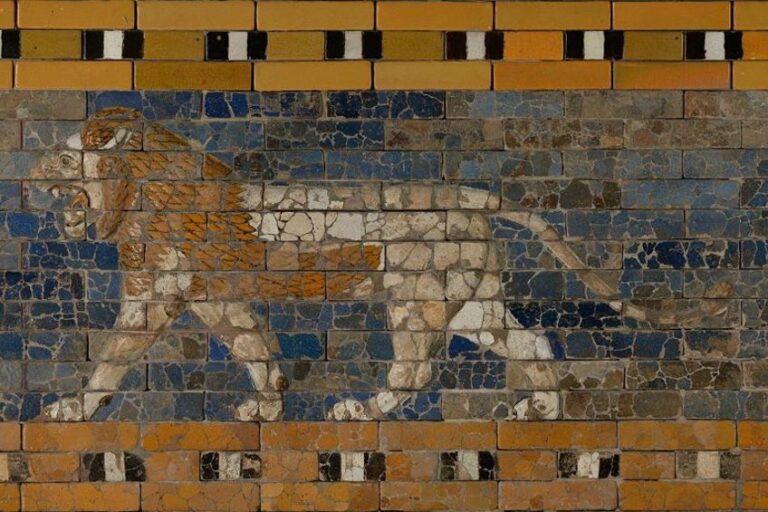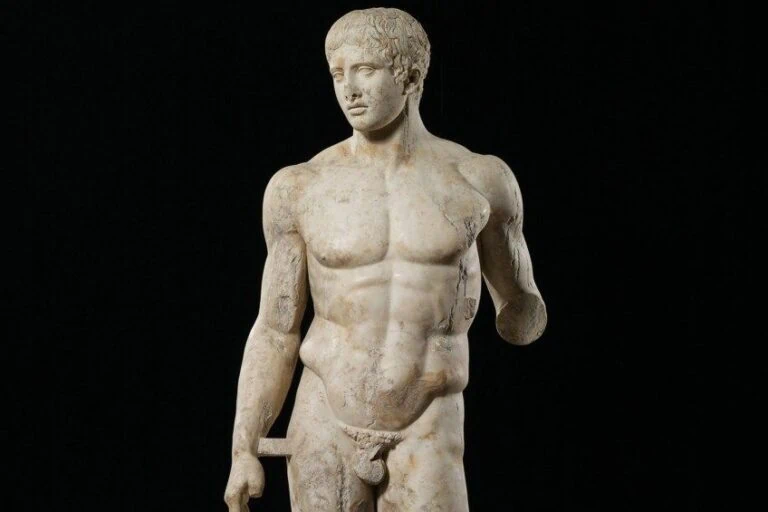Leaning Tower of Pisa – The Mystery of Italy’s Tilting Bell Tower
We have all seen photos of this famous building in Italy, usually consisting of tourists pretending to keep the Leaning Tower of Pisa from falling over. What is the angle of the Tower of Pisa and how tall is the Leaning Tower of Pisa? We will answer these and many other questions, and find out what the Pisa Tower’s inside spaces look like.
Contents
The Story of the Leaning Tower of Pisa
| Architect(s) | Bonanno Pisano (c. 1150) |
| Year Completed | 1399 |
| Function | Bell Tower |
| Location | Piazza del Duomo, Pisa, Italy |
In the 12th century, Pisa had risen from a minor maritime town to a regional powerhouse, owing mostly to the money amassed from the successful invasion of Sicily and Palermo. Pisa began to spend its resources in the form of big monuments with extravagant architecture to demonstrate its affluence. As a result, the Piazza dei Miracoli was created. The Pisa Cathedral, cemetery, baptistry, and huge bell tower were all planned to be built inside this property. As a result, the huge bell tower known today as the Leaning Tower was erected.
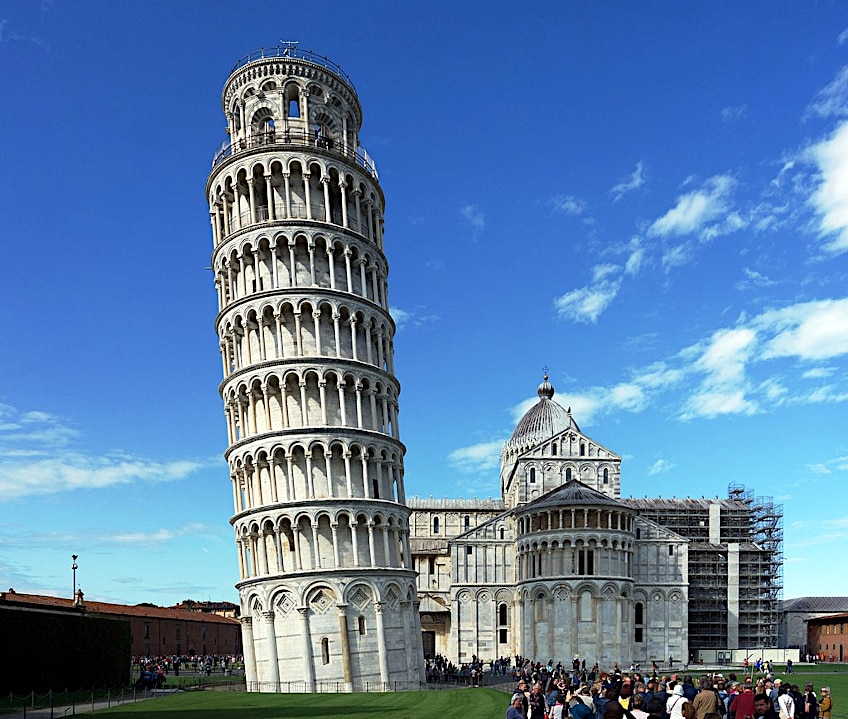 Leaning Tower and Cathedral at Pisa; Spike, CC BY-SA 4.0, via Wikimedia Commons
Leaning Tower and Cathedral at Pisa; Spike, CC BY-SA 4.0, via Wikimedia Commons
Where is the Tower of Pisa located, though? The development of the bell tower made for Pisa’s cathedral structure is situated between the Serchio and Arno rivers in Tuscany, central Italy, and commenced in 1173. This plaza is located along the city’s defensive wall on the northwestern outskirts of Pisa. It is regarded as one of the most attractive urban areas in the world, with beautiful green lawns where visitors and residents alike enjoy relaxing and admiring the landmarks and architecture. The tower’s foundation had begun to sink irregularly on the ground underneath it, a thick combination of sand, clay, and shells, by the time workers had completed three of eight intended levels some five years later.
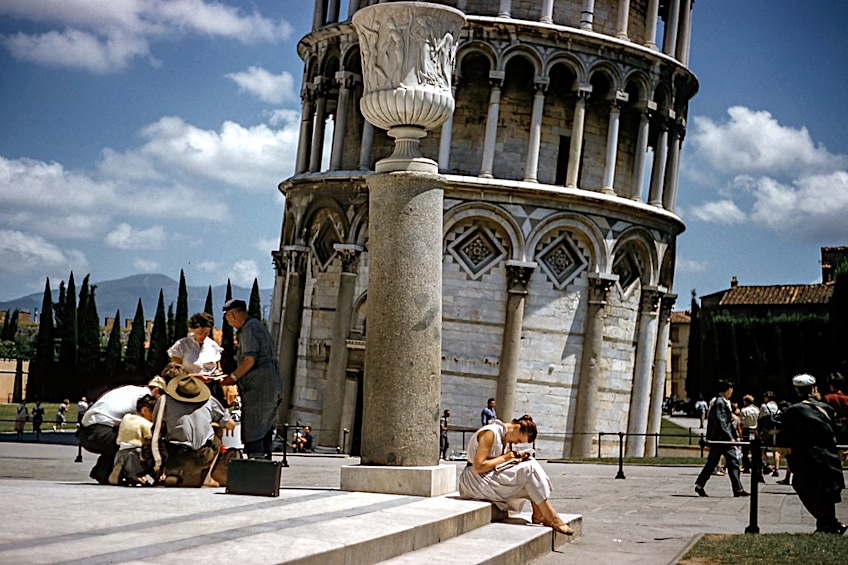 Base of the Leaning Tower of Pisa; Les Anderson lesanderson, CC0, via Wikimedia Commons
Base of the Leaning Tower of Pisa; Les Anderson lesanderson, CC0, via Wikimedia Commons
As a consequence, the building began to lean noticeably to the south. Soon after, conflict broke out between Genoa and Pisa, another Italian city-state, effectively stopping building for over a hundred years. This interval allowed the foundations to settle more, preventing the bell tower from collapsing prematurely.
There is more to the story, though, so let us take a deeper look into the events that occurred leading to the construction of this famous building in Italy.
The Architect of the Leaning Tower of Pisa
The actual identity of the architect has been the subject of debate for many years. Architects Giovani di Simone and Gherardo di Gherardo were among those thought to be behind the famous building in Italy over the years. University archaeologists in Pisa say they have finally verified the identity of the iconic Leaning Tower of Pisa’s initial architect. For many years, a man named Bonanno Pisano went unknown because he felt humiliated by how the structure turned out.
The unfortunate man died never knowing what a wonder he had constructed that would still be admired centuries later.
 View of the Tower and the Duomo at Pisa (18th Century); Rijksmuseum, CC0, via Wikimedia Commons
View of the Tower and the Duomo at Pisa (18th Century); Rijksmuseum, CC0, via Wikimedia Commons
During an 1838 excavation, a stone containing Bonanno Pisano’s name in Latin was discovered embedded in the foundation of the tower. In 2019, paleographers were able to decipher lines engraved into the stone that reads: “I, who beyond a question of doubt created this beautiful work that surpasses all others, am a resident of Pisa named Bonanno”.
Scholars largely agree that this is the final proof needed to state confidently that Bonanno designed the structure. Bonanno Pisano envisioned the bell tower of Santa Maria Assunta to be a beautiful tribute to God when it was built in 1173.
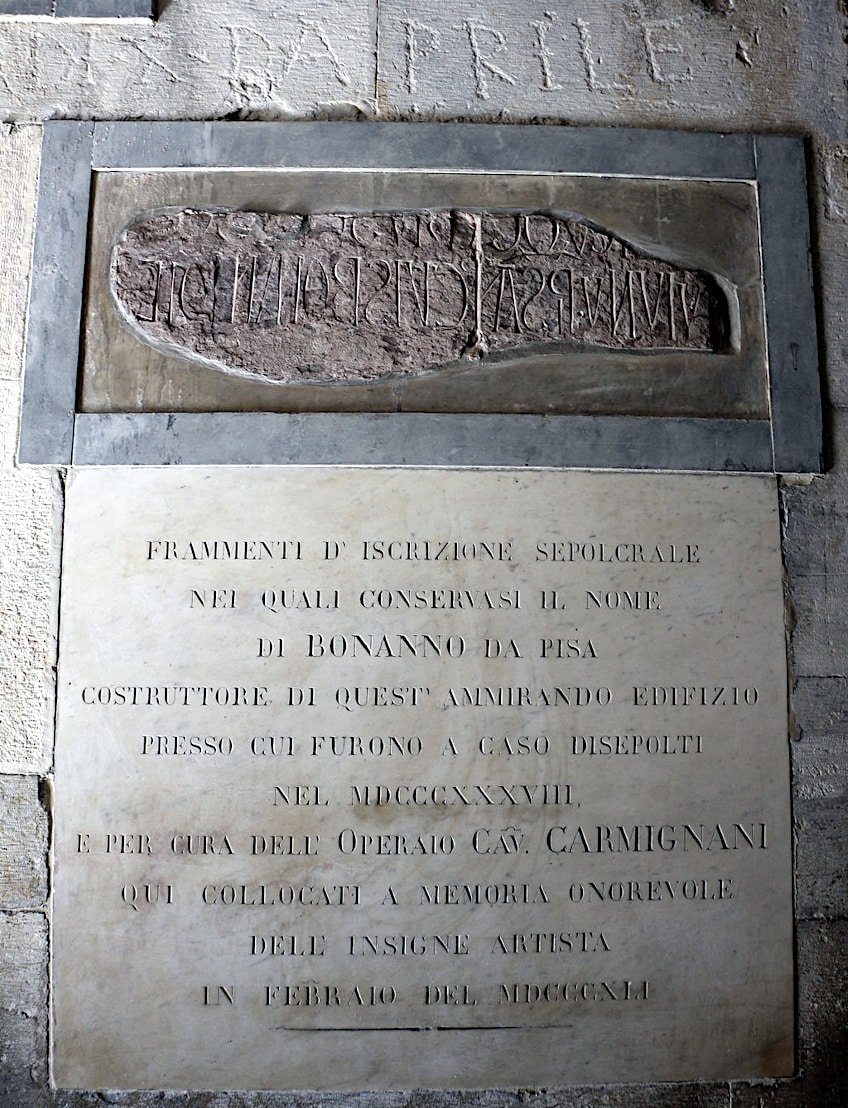 Fragment of the Bonanno da Pisa inscription; Sailko, CC BY 3.0, via Wikimedia Commons
Fragment of the Bonanno da Pisa inscription; Sailko, CC BY 3.0, via Wikimedia Commons
However, by the time workmen reached the tower’s third floor, it was evident that it was slanted. Pisano is said to have slipped into anonymity after being devastated about the inadequacy of his masterwork. Historically, the stone was thought to have been removed from his tomb. However, this isn’t the first occasion Pisano has been attributed with the building of the famed tower. Giorgio Vasari stated in the 16th century that Pisano was the architect behind the tower. He was also responsible for the bronze entrances of the Pisa Cathedral.
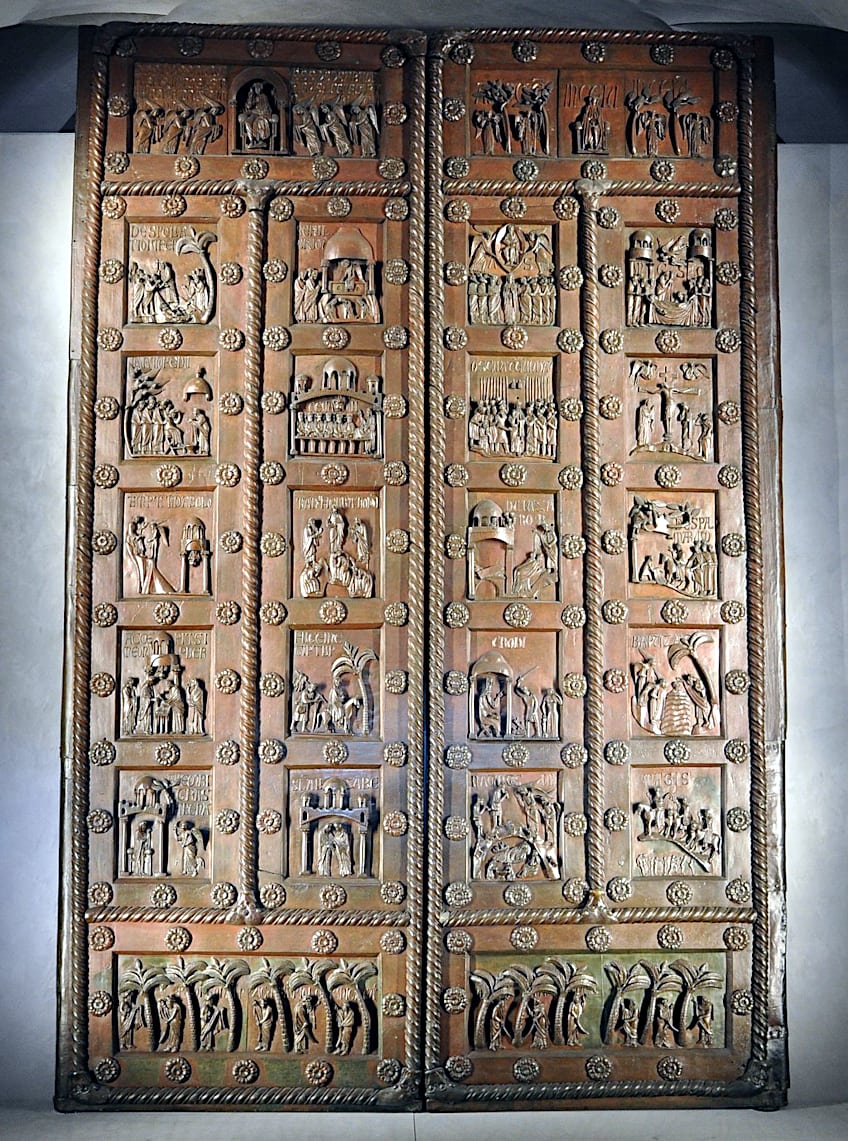 San Ranieri door by Bonanno Pisano (1180); Bonanno Pisano, CC BY-SA 4.0, via Wikimedia Commons
San Ranieri door by Bonanno Pisano (1180); Bonanno Pisano, CC BY-SA 4.0, via Wikimedia Commons
Construction of the Leaning Tower of Pisa
The tower was built in three sections over the course of around 200 years. Donna Berta di Bernardo donated 60 soldi on the 5th of January 1172, which was used to buy a few stones that now serve as the foundation of the bell tower. The tower’s foundations were set on the 9th of August 1173. Construction of the ground level started on the 14th of August. The blind arcade on the ground level is supported by engaged columns with Corinthian capitals. “Guglielmo, based on what is stated, constructed the foundation of the church’s tower in 1174, together with sculptor Bonanno Pisano”, wrote Giorgio Vasari almost 400 years later. In 1178, after they reached the second story, the structure started to sink.
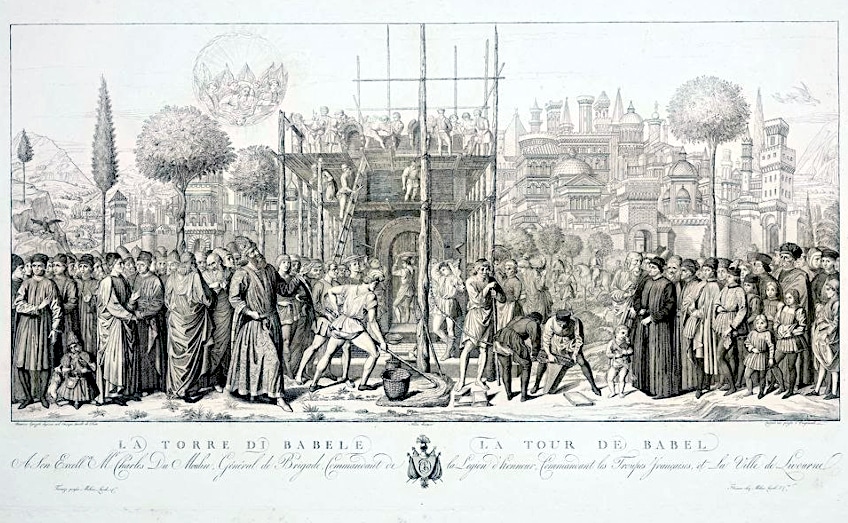 The Tower of Babel by Conte Carlo Lasinio after the frescoes by Benozzo Gozzoli in the Campo Santo in Pisa (published 1812); Carlo Lasinio, Public domain, via Wikimedia Commons
The Tower of Babel by Conte Carlo Lasinio after the frescoes by Benozzo Gozzoli in the Campo Santo in Pisa (published 1812); Carlo Lasinio, Public domain, via Wikimedia Commons
This was owing to a three-meter foundation situated in a poor, unstable subsurface, a design error from the start. Construction was then suspended for about 100 years due to the Republic of Pisa’s constant conflicts with Lucca, Genoa, and Florence. This gave the underlying dirt time to settle. Otherwise, it would have almost certainly collapsed. On the 27th of December 1233, the son of Gerardo Bottici, Benenato, supervised the tower’s continued construction. The son of Giovanni Pisano, Guido Speziale, was picked to further supervise the tower’s construction on the 23rd of February 1260.
On the 12th of April 1264, the architect of the Camposanto, Giovanni di Simone, and 23 laborers traveled to the mountains outside Pisa to quarry marble. Di Simone continued building in 1272. To mitigate the tilt, the engineers built upper stories with one edge higher than the other. As a result, the tower is bent.
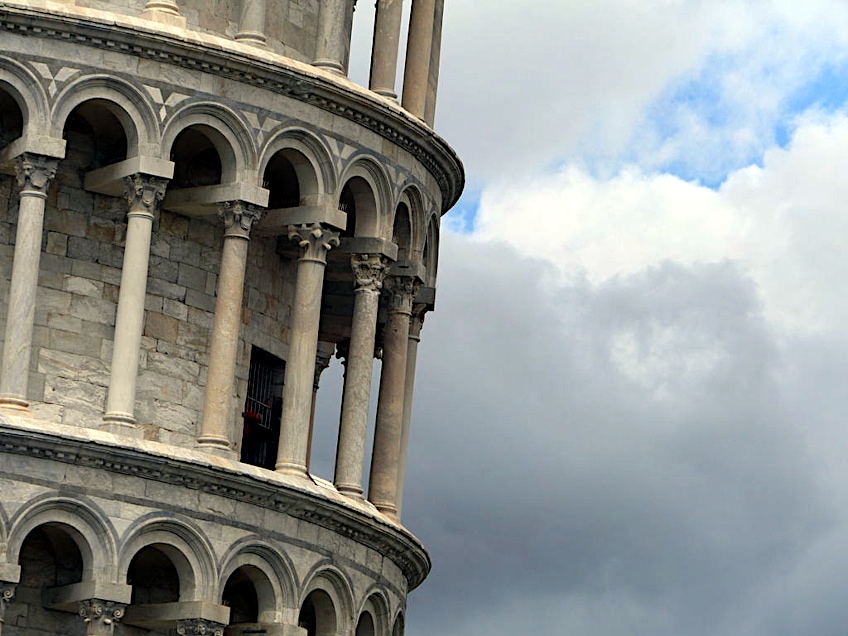 Close-up-of the Leaning Tower of Pisa; Dawid Skalec, CC BY-SA 4.0, via Wikimedia Commons
Close-up-of the Leaning Tower of Pisa; Dawid Skalec, CC BY-SA 4.0, via Wikimedia Commons
When the Pisans were beaten by the Genoese in the Battle of Meloria in 1284, construction was once again suspended. In 1319, the seventh story was built. In 1372, the bell chamber was eventually constructed. Tommaso di Andrea Pisano designed it, balancing the Gothic characteristics of the belfry with the Romanesque-like design of the structure. Each note of the musical major scale is represented by one of the seven bells, the biggest of which was built in 1655.
After Construction
Galileo Galilei, who resided in Pisa at the time, is reported to have shot two cannonballs of various weights from the tower between 1589 and 1592 to prove that their rate of descent was unrelated to their mass, in accordance with the rule of free fall. The biography, written by Galileo’s disciple and assistant Vincenzo Viviani in 1654 but not published until 1717, years after his passing, is the main source for this account. The Allies accused the Germans of using the structure as an observation station during WWII. The splendor of the cathedral and its campanile impressed a U.S. Army sergeant, Leon Weckstein, dispatched to verify the presence of Germans in the tower, and he abstained from commanding an artillery attack, saving it from destruction.
 Russian Commemorative coin featuring Galileo and the Tower of Pisa; Банк России, Public domain, via Wikimedia Commons
Russian Commemorative coin featuring Galileo and the Tower of Pisa; Банк России, Public domain, via Wikimedia Commons
Many attempts have been undertaken to return the structure to a more vertical orientation or to protect it from collapsing. Most of these initiatives failed, and some aggravated the tilt. On the 27th of February 1964, the Italian government requested assistance in keeping the tower from collapsing. However, it was thought necessary to keep the present tilt because of the role it played in boosting Pisa’s tourism sector. The tower’s alignment was marginally improved with the addition of 870 tons of lead counterweights in 1993.
The tower, as well as the nearby baptistery, cathedral, and cemetery, are a UNESCO World Heritage Site, which was designated in 1987. The famous building in Italy was closed to the general public on the 7th of January 1990, following more than 20 years of stabilization research prompted by the 1989 collapse of the Civic Tower of Pavia.
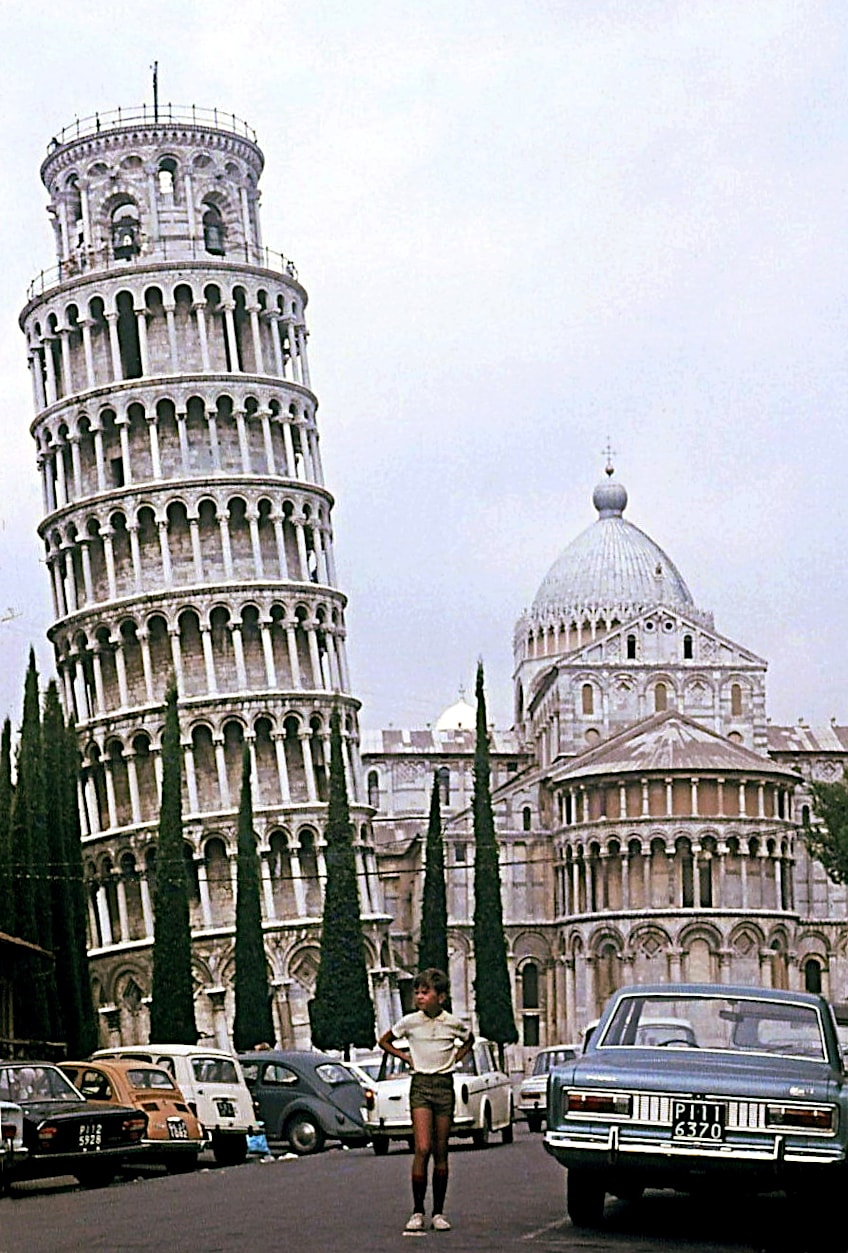 Leaning Tower of Pisa in 1969; Bubeníček family, CC BY-SA 4.0, via Wikimedia Commons
Leaning Tower of Pisa in 1969; Bubeníček family, CC BY-SA 4.0, via Wikimedia Commons
The bells were removed, and cables were looped around the third floor and fastened at a distance of several hundred meters to help lighten the load. Apartments and residences in the way of possible collapse were vacated due to safety concerns. The chosen strategy for averting the tower’s collapse was to remove 38 cubic meters of earth from beneath the higher end to slightly lessen its tilt to a safer degree. The tilt of the tower was decreased by 45 cm, restoring it to its 1838 position.
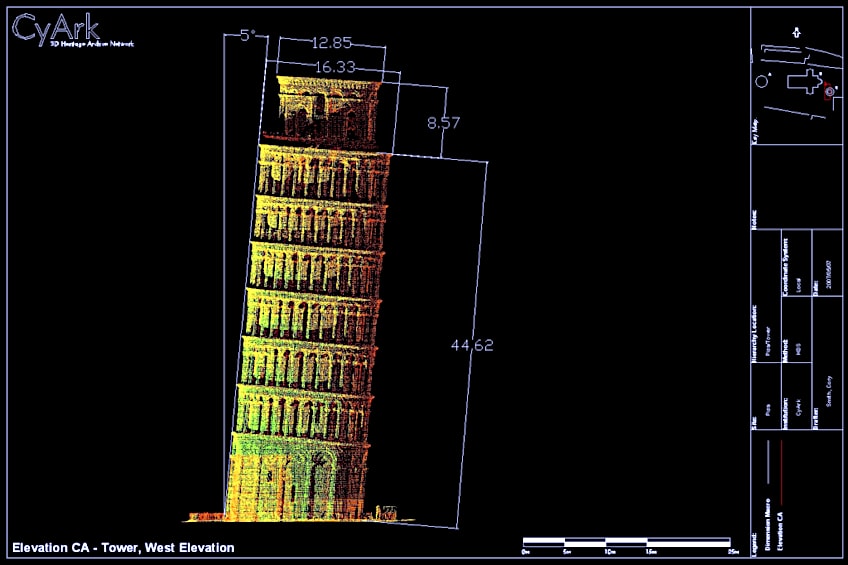
Angle of the tilt of the Leaning Tower of Pisa in 2007; CyArk, https://www.cyark.org/data-use-policy, CC BY-SA 4.0, via Wikimedia Commons
The Leaning Tower of Pisa reopened on the 15th of December 2001, after a decade of corrective rebuilding and stabilization operations, and was certified stable for at least another three centuries. Following a period of structural reinforcement, the tower has undergone incremental surface restoration to correct obvious deterioration, mostly blackening and corrosion. These are especially noticeable because of the age of the structure and exposure to rain and wind.
Engineers stated in May 2008 the structure had been stabilized and was not moving for the first time in its existence. According to them, it would remain steady for at least two centuries.
The Pisa Tower Inside
It has stunning marble columns on each story and two sets of spiral stairs. The entry leads to a waiting room where you must wait your turn to ascend the tower. The light from the windows on the top stories illuminates the interior. The stairs inside the tower have been significantly degraded over time. The inside of the famous building in Italy is essentially hollow, with polished marble walls and a diminishing flight of steps, as well as a few modified protection and stabilizing modifications.
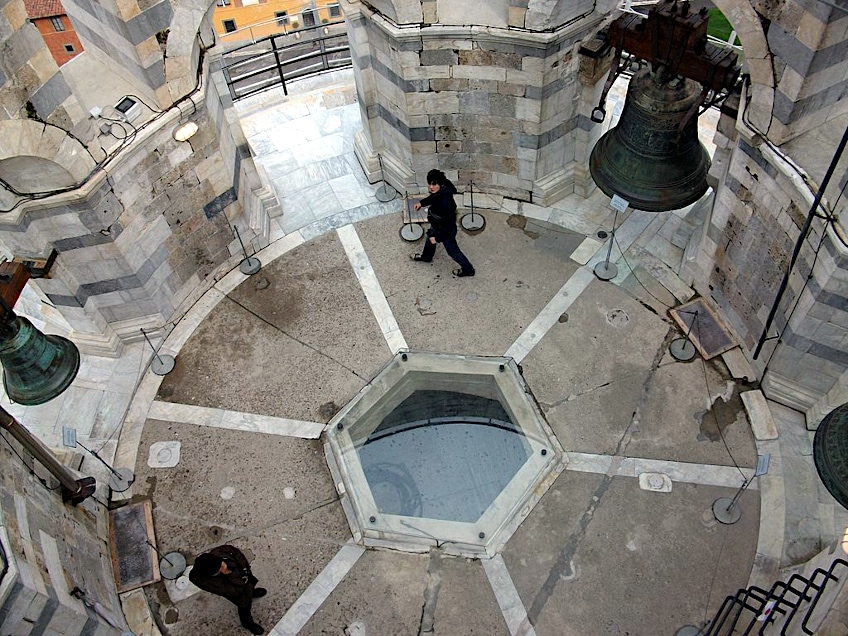 Interior of the Bell Tower of Pisa Cathedral; Joanbanjo, CC BY-SA 3.0, via Wikimedia Commons
Interior of the Bell Tower of Pisa Cathedral; Joanbanjo, CC BY-SA 3.0, via Wikimedia Commons
Because the Leaning Tower of Pisa is relatively narrow, there is no room for visitors’ belongings and bags. When you enter the tower, chilly air envelops you, compliments of the marble, and you begin your ascent. There are 7 platforms on your way up where you may pause and take in the spectacular views, but the topmost platform is without a doubt the nicest. Because of the size limit of the Pisa Tower’s inside space, there are certain rules in place for visitors to follow.
The queues are usually long too, as they only allow a maximum of 45 people in at any given time. The stairs are rather hard to ascend due to the weird angles and visitors only get 30 minutes each to go to the top, take in the view, and then make their way back down again.
Adjoining Sites
Pisa is well renowned for its Leaning Tower, but the city also has many other attractions, such as the lovely Cathedral Square or Piazza dei Miracoli. In addition to the Leaning Tower, we can view the church and the baptistery from here. The Opera Museum, The Cemetery, and the Sinopie Museum are also located along the square’s edge. Take a stroll along the Arno River until you hit the old Clock Palace and Knight Square, where the famed Scuola Normale di Pisa is situated.
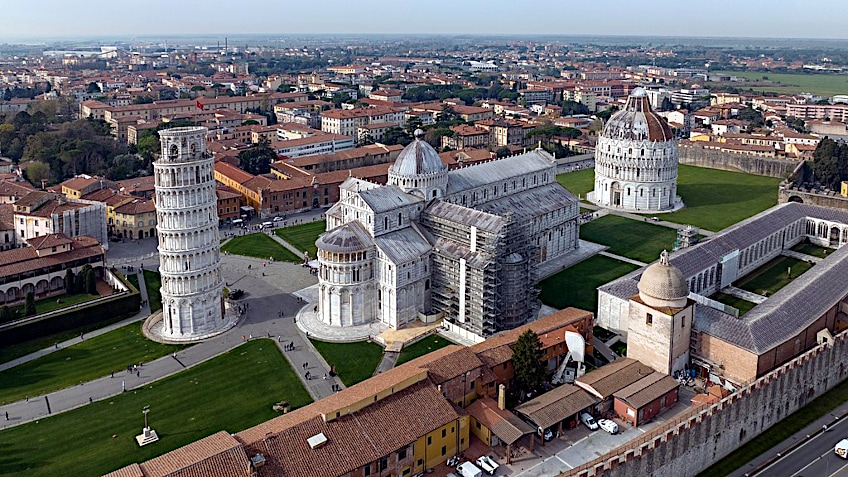 Cathedral Square in Pisa, Italy; Arne Müseler / www.arne-mueseler.com, CC BY-SA 3.0 DE, via Wikimedia Commons
Cathedral Square in Pisa, Italy; Arne Müseler / www.arne-mueseler.com, CC BY-SA 3.0 DE, via Wikimedia Commons
The Piazza dei Miracoli is not located in the city center, as one might expect, but rather near the northwestern perimeter of the city’s defensive wall, just outside the center. When building on the cathedral began in 1094, this was the only accessible area. The three monuments in the plaza have been deemed fundamental to religious life since the Etruscans, signifying the key stages of human existence: the Baptistery depicts birth, the Cathedral of Santa Maria Assunta life, and the Camposanto, of course, refers to death.
As the bell tower, the iconic Leaning Tower of Pisa is regarded as a part of the cathedral.
The Leaning Tower and Earthquakes
The famous building in Italy is located in an earthquake-prone area of the country and has been subjected to numerous large earthquakes throughout its history. One of the most serious earthquakes that the tower endured happened in 1556 when an earthquake with a magnitude of roughly 7.0 on the Richter scale rocked the neighborhood. This earthquake exacerbated the tower’s lean and damaged numerous other structures in the city.
 The leaning tower of Pisa, with the chevet of the Duomo on the left by Jean Baptiste Isabey (1822); British Museum, Public domain, via Wikimedia Commons
The leaning tower of Pisa, with the chevet of the Duomo on the left by Jean Baptiste Isabey (1822); British Museum, Public domain, via Wikimedia Commons
Another large earthquake, with a magnitude of 6.3, occurred in 1920. This earthquake pushed the tower to tilt even further, causing more structural damage. In more recent years, it has been modified with a multitude of earthquake-resistant features. The placement of lead weights at the foot of the tower is one of these solutions, which helps to offset the lean and reduces strain on the framework.
Additionally, it was strengthened with steel cables and an interior bracing system to assist support. Despite these precautions, the tower is still vulnerable to seismic damage and is regularly observed for any symptoms of motion or structural instability. Nevertheless, owing to the work of engineers and conservationists, the tower has survived multiple earthquakes and continues to stand as a tribute to the brilliance of its creators.
The Leaning Tower of Pisa in Popular Culture
The Leaning Tower of Pisa is a well-known landmark that has appeared in a number of pop culture settings. Several movies, television shows, and computer games have depicted the famous building in Italy, including National Treasure (2004), The Italian Job (2003), and Assassin’s Creed II (2009). It is commonly utilized as a symbol of Italy or European culture and is usually represented as a background for adventure or action sequences. The structure has also been used as a background for a number of athletic events, including the World Cup and the Summer Olympics.
It’s also seen in a number of advertisements and advertising campaigns and is still celebrated as the site of Galileo’s experiments with gravity.
The Leaning Tower of Pisa is one of the world’s most prominent tourist attractions. The famous building in Italy is not just one of the world’s seven wonders, but it is also a UNESCO World Heritage Site. The immense weight of this structure, made of pure white marble, forced the earth beneath its badly constructed base to move. It should have collapsed at one stage as well, but it mysteriously remained upright as experts labored to fix the tilt, making it a real engineering miracle. Despite always seeming on the verge of collapse (or perhaps because of it), the Leaning Tower of Pisa has become an enduring and iconic emblem of Italy’s rich cultural legacy and has become a globally recognized monument.
Frequently Asked Questions
Where Is the Tower of Pisa Located?
The Leaning Tower is located in the Italian region of Tuscany, in the city of Pisa. Pisa is a city with a long history dating back to antiquity. It was a major trading and business hub, as well as the home of many powerful families and political officials. The tower is in the Piazza del Duomo, an open space in the city’s core. Other notable monuments in the Piazza are the Pisa Cathedral as well as the Baptistery, both of which are UNESCO World Heritage Sites. This area is regarded as a major tourist attraction because of its stunning architecture and rich cultural heritage. The soft terrain on which the tower was built is one of the most prominent features of the surrounding area. The ground is made up of sand, clay, and silt layers that are prone to shifting and moving. This is what prompted the tower to begin tilting during construction and has kept it leaning for generations.
How Tall Is the Leaning Tower of Pisa?
The Leaning Tower stands 55 meters tall and requires walking 294 stairs to climb to the top. Except for the last level, which contains the seven bells, each level features arcades and galleries. There have been periods where people were not able to access the tower and walk to the top, as it was considered too dangerous. However, currently, it is open to tourists who can experience the height (and slant) of this famous building in Italy for themselves.
What Is the Angle of the Tower of Pisa?
The angle of the Leaning Structure of Pisa has altered throughout time due to a variety of circumstances, including the unstable ground on which it was constructed and successive attempts to stabilize the tower. The angle of the tower is roughly 3.97 degrees as of 2022, which is less than it was in the past. Engineers stepped in in the late 20th century to stabilize the tower and save it from toppling. They accomplished this by adding lead weights at the tower’s base to offset the lean, as well as strengthening the construction with steel cables and internal bracing. These initiatives have helped to minimize the tower’s lean and make it more stable. Before the implementation of these stabilizing operations, the tower had a far more apparent lean of around 5.5 degrees.
Who Built the Leaning Tower of Pisa?
Bonanno Pisano, the project’s chief architect, is credited with planning and supervising the tower’s construction. Pisano was a well-known engineer and architect who resided in Pisa during the 12th century. Other architects and engineers, such as Gherardo di Gherardo and Giovanni di Simone, supported him on the project in various roles. Several sources acknowledge Bonanno Pisano’s role in the tower’s construction. One of these sources is the Pisan Chronicle, a 13th-century manuscript that offers a thorough account of the history of the city of Pisa. The document expressly names Pisano as the tower’s principal architect and credits him with planning and supervising its construction.
What Stops the Leaning Tower of Pisa from Toppling Over?
Several steps have been attempted to stabilize the Leaning Tower of Pisa in Italy and keep it from collapsing. Engineers put lead weights at the tower’s base to offset the lean and decrease structural strain. Steel cables have been installed to assist and sustain the tower and keep it from toppling. Engineers also placed an internal bracing system within the leaning tower to assist in stabilizing it and keep it from collapsing. Engineers have already scraped earth from beneath the tower’s base in an attempt to stabilize it. The tower is continuously monitored for any indications of movement or structural instability, and any required repairs or stabilizing measures are implemented as needed. Collectively, these efforts have helped to stabilize the structure and keep it from falling, although it remains vulnerable to deterioration from earthquakes and other external forces.

I am deeply passionate about history and am constantly fascinated by the rich and complex stories of the past. As the editor-in-chief of learning-history.com, I have the opportunity to share this passion with a wide audience through the creation and distribution of engaging and informative content about historical events, persons, and cultures. Whether it’s through writing articles and blog posts or creating videos or podcasts, I strive to bring the past to life in a way that is both accurate and enjoyable. My expertise in history, combined with my strong writing and communication skills, allows me to effectively communicate complex historical concepts and make them accessible and interesting to a wide range of readers. I am truly grateful for the opportunity to share my love of history with others through my work on learning-history.com.



